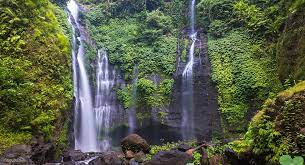
It is true as a saying goes that the grass is always greener on the other side of the fence and it may be nature of human who want to find, see and enjoy something different or what they do not have in their own country or place. It is also not exaggeration to say that Bali, a small island in the Indonesian archipelago has been famous as a tourist destination all over the world since the Dutch colonial era which has been colonized the archipelago for centuries.
On the north of Bali, covering the almost one-third of the entire size of Bali is virtually emerging as a new tourist destination even though that the region was initially visited by mostly back-packers motivated by their adventures of finding a new experiences with budget style.
Lovina, on the northern coast with its black sand and docile nature of the sea in contrast with the Kuta beach was the first tourist destination. .The surveys shows that tourists prefer white-sand and strong gales suitable for surfing such as in Kuta, North Bali has a lot of tourist attractions even though there are not knows yet or deserves to be called “the Hidden treasures of North Bali”.
One of them is Bali Aga. Bali Aga, in English, Aga means “mountain” so Bali Aga refer to that the Balinese who live in mountain. In Bali it is acknowledged there are several villages as Bali Aga such asTrunyan in the Regency of Bangli, Tenganan in the Regency of Karangasem and seven villages in the North Bali, or in the Regency of Buleleng, namely on the east of the regency are Sembiran and Julah and on the western of the regency namely the villages of Sidetapa, Cempaga, Tigawasa, Pedawa and Banyusri. In general all of these Bali Aga’s villages clearly differentiate with the rest of currently Balinese.
On this article we are focusing on the villages of Bali Aga on the north of Bali’ The five villages are situated in the Distrct of Banjar, in the Regency of Buleleng, approximately 20 km south west of Singaraja, the capital of the Regency of Buleleng and approximately 75 km from Denpasar the capital of the Bali Province.
Those tourists and travelers alike who are traveling to Bali Aga certainly are wondering to notice the people’s houses. They might see as very bizarre but amazing. It is only for instance, such as at the village of Sidetapa, one is easily able to find out in one family house that all activities are carried out in one room of the house such as sleeping, cooking, storing all of their clothing and ritual equipments.
This note-worthy bizarre raises question, why so? It is a long legendary history of that and in short it is as told that in the old days there was a ogre roaming the villages threatening the people so that the house was designed in such a way with narrow alley between houses, small window even without window and all activities were done in one room of the house.
In addition of the unique traditional customary houses (Rumah Adat), in the villages there are also can be found so many traditional sacred dances which are staged on special occasion such as temple ceremony or other occasion relating with ritual of the villages. Those who are lucky visiting the villages and the dances happen being held would be lucky to enjoy it.
In the globalization era, everything is changing so are the villages of Bali Aga. Bali Aga’s villages are no longer isolated as they were, currently are more easily accessible and the people more educated and due to the lucrative of clove and coffee commodities in general the welfare of the people are stepping up or more well-to-do.
They are now are able to build more modern houses adopting new trend in style and architecture but what is interesting to note that they have strong spirit of respecting and preserving their ancestor’s tradition. and preserving their tradition as it was, so modern and tradition go hand in hand in harmony and this is the magnet of Bali Aga as a tourist destination. The uniqueness which cannot be found anywhere in the world and how far it can go that way everything will depend of the people of the villages in question (Suwela)



